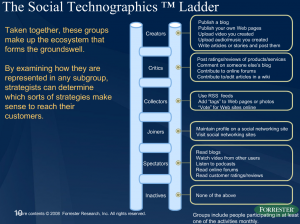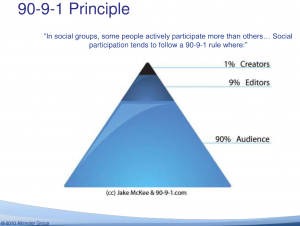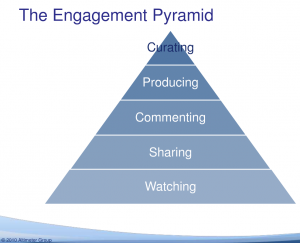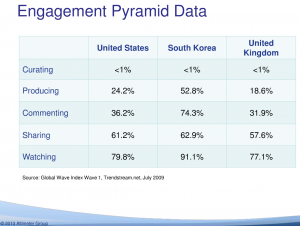Category Archives: Social Networking
#VT’s new Lt. Gov. pushes Civic Engagement
New Vermont Lt. Governor Phil Scott (Rep.) was sworn in yesterday and gave a speech centered on civic engagement. I invite our new Lt. Gov. to see how Front Porch Forum is helping Vermont neighbors connect and get involved locally… e-Vermont too. Some choice quotes…
… as many of you know, 46 percent of registered voters didn’t vote in November. That’s 209,000 Vermonters whose only choice on November 2 was not to show up. They decided it wasn’t worth it, or it didn’t matter, or it wouldn’t do any good, to make their voice heard. My experience shows that’s just not the case… I don’t think any of us fully realized until November 2 what that frustration had turned into; it turned into 209,000 people who had apparently given up… Civic involvement isn’t something that’s only relevant on even-numbered years.
All of us here in the Legislature need to reach out to those folks and welcome them in, even when we might not agree with their views. We need to open our doors. In order to live up to the intentions and the expectations of our accessible government, we ourselves need to be more accessible. That will mean different things for each of us. For me, that means literally opening my office door downstairs a morning or two a week and inviting you in for coffee and conversation. It means opening my virtual doors…
When I challenge Vermonters to get involved, I’m not just talking about the work we do in Montpelier. Because I really believe we all want to help each other; sometimes we just need to know how… one theme that I’ve stressed… is self-reliance, and its partner, volunteerism. In my mind, those are two sides of the same coin. Being self-reliant doesn’t just mean looking after yourself, although that’s important… But self-reliance also means looking after our neighbors, and giving them the support they may need to get to the next step in their lives.
That has a lot of implications.
- That means buying local, and supporting the merchants on Main Street instead of the website in California.
- That means helping Vermont’s manufacturers to identify suppliers and trading partners who are here within our borders or close by in our region.
- That means making it easier and more affordable for more of us to eat local food, supporting our farmers, reducing transportation costs, and getting fresher and healthier things to eat.
- That means investing in energy policies that help us become more independent.
Personally, I suspect that a great deal of the collective frustration that caused those 209,000 people to stay home on November 2 was the sense that our elected officials and candidates kept talking about the goals — creating jobs, jump-starting the economy, and helping our most vulnerable — but didn’t talk enough about how we would get there. Buying local and encouraging innovative local partnerships are part of my vision for how we do it…
Our challenge in Montpelier is to come up with solutions that will strengthen Vermont. Your challenge is to come up with solutions that will help your neighbor and strengthen your community. If we all work together, we will strengthen the legacy of the state that we love to call home.
Thou shalt not question Facebook
I’m shocked that John Stewart would cast aspersions on our omniscient corporate overlord. How dare he! It’s imperative that we all march lock-step into Facebook’s warm embrace.
| The Daily Show With Jon Stewart | Mon – Thurs 11p / 10c | |||
| The Anti-Social Network | ||||
|
||||
Hiding in Plain Sight
Vermont Public Radio commentator Andrea Learned chimed in today with a piece called “Sustainable Waldo.”
I’ve been thinking a lot lately about how to nudge more people toward sustainable living practices. While switching out light bulbs and recycling as much as possible are both easy ways to start that process, what comes next? … we may now need to focus on places where sustainability is hidden in plain sight… Remember the “Where’s Waldo” books? Darned if he wasn’t right in front of your nose and you didn’t see him. So where are some sustainability Waldos?
One great example might lie in urban density and community transportation planning issues… Gardening is another activity where sustainability may be hiding in plain sight.
And what about neighborhood involvement, as supported by services like Vermont’s own Front Porch Forum, which host networks of online neighbor-to-neighbor help and information. Communities built on stronger interpersonal relationships and citizen interconnections help build more long-term, sustainable views on big, challenging issues. Whether or not citizens see this as sustainability doesn’t really matter. They are responding to powerful, sustainability-promoting, shared values.
She’s got a point! Sometimes we talk about FPF’s larger community benefits… but most of the time when chatting with folks, we focus on the direct and obvious benefits… use FPF to find an affordable plumber or ride to Boston, to report a car break-in to neighbors, to sell a bike or give away a stroller.
Cities, neighborhoods, community and Jane Jacobs
Convergence from my reading pile…
- Richard Florida: Who’s Your City: How the creative economy is making where to live the most important decision of your life, 2008.
- Jonah Lehrer, NYTimes Magazine, A Physicist Solves the City, Dec. 19, 2010.
- John McKnight and Peter Block: The Abundant Community: Awakening the Power of Families and Neighborhoods, 2010.
Each author talks about cities and neighborhoods, and residents’ decisions about where to live and how to live within their communities. They all reference Jane Jacob‘s pioneering work in community and urban planning. And each is well worth reading.
The Times article examines the research of Geoffrey West who is developing equations that he claims describe cities… parallel to the laws of physics. E.g., “whenever a city doubles in size, every measure of economic activity… increases by 15 percent per capita.” Which leads to the idea that moving a person to bigger and bigger cities will make her more and more economically productive.
Richard Florida’s book is full of interesting survey data. Take a look at his maps. Here’s a sample…

Finally, the most compelling and visionary of the lot to this reader is The Abundant Community. McKnight and Block, from a lifetime of experience lay out their case for “a new possibility for each of us to live a more satisfying life” by joining “our neighbors to live and create a community that nurtures our family and makes us useful citizens.” Lots of tactics and examples placed in a useful framework. Many neighborhoods and rural towns in Vermont are using Front Porch Forum in this way and it’s beautiful to behold.
Feelings lead to action
Richard Millington’s post today got me thinking…
Feelings provoke actions… Focus on making members feel more engaged, not act more engaged.
Many times a day, Front Porch Forum pilot members are moved to be more engaged in FPF… and, more importantly, many are move to be more engaged in their actual/non-virtual neighborhood. This is often brought about by feelings elicited by an FPF posting from a neighbor.
Here are two key references from Millington…
You’ve probably come across the technographics ladder or the socialgraphics engagement pyramid. These categorize members by their actions. Lurkers are at the bottom, creators at the top. Sharing, reading, tagging are in-between.
First, the technographics ladder…

And the socialgraphics engagement pyramid…



Mark Suster on Social Networking
Entrepreneur and venture capitalist Mark Suster open his blog post today with …
What I want to answer with this post (long though it may be) is:
- Why did Web 2.0 emerge and are there any lessons to be gained about the future? [cheap accessible digital hardware]
- Why did Twitter emerge despite Facebook’s dominance? [asymmetry, real-time, curated RSS / link-sharing]
- Why did MySpace lose to Facebook & what can Twitter learn from this? [encouraging an open platform where 3rd parties can make lots of money]
- Does Facebook have a permanent dominance of the future given their 500m users? [chuckle. ask microsoft, aol/time warner & google]
- What are the big trends that will drive the next phase of social networks? [mobile, locations, layering of services, data management, portability & more]
An excellent piece… worth the whole read. Shortened version here… and full version here.
New study: Neighborhood websites build community and get people involved
Congratulations to UK’s Hugh Flouch and Kevin Harris on the publication of the results of their new study…
Do neighbourhood websites have a positive social impact locally? For those who’ve suspected and long wanted convincing evidence, we think the wait is over.
The report of the Online neighbourhood networks study was launched yesterday during a lively conference in London…
Our study looked at three neighbourhood sites in London. The research shows that they serve to enhance the sense of belonging, democratic influence, neighbourliness and involvement in their area. Participants claim more positive attitudes towards public agencies where representatives of those agencies are engaging online.
We’ve produced a short (4-page) summary, an extended summary, a full report divided into digestible chunks, a selection of video interviews, together a number of other papers, and we will continue to add to these.
We see similar trends with Front Porch Forum in our pilot region. That is, FPF members report… (1) better connection to neighbors and neighborhood, (2) a more prominent voice in local decision-making, (3) a friendlier environment, and (4) increased civic engagement.
Miscellaneous findings from the UK report…
95% – Feel more informed about neighborhood
92% – Neighbors are helpful if asked for advice
69% – Increased sense of belonging within neighborhood
92% – Useful information gets shared efficiently
82% – People pull together to improve neighborhood
63% – Main source of local news
44% – Neighbors more likely to lend items or exchange favors
42% – Met a neighbor
54% – More likely to see a neighbor you recognize due to website – Active member
14% – More likely to see a neighbor you recognize due to website – Passive member
This collection of materials is worth a close look!
About Blog
Ghost of Midnight is an online journal about fostering community within neighborhoods, with a special focus on Front Porch Forum (FPF). My wife, Valerie, and I founded FPF in 2006... read more
Post Categories
- Uncategorized
- PDF2009
- Calendar
- Northeast Kingdom
- podcast
- Peer Rental
- Localization
- Big Tech
- Events
- PDF2007
- Web Traffic
- Google AdSense
- Pay It Forward
- Elections
- berkmansunlight
- Maps
- Video
- Upstate New York
- Coupons
- Wildlife
- Mobile
- Viral Marketing
- Raffle
- Crisis Response
- Donations
- Lost & Found
- Real Estate
- College Students
- Gratitude
- Social Responsibility
- Orton Family Foundation
- Start ups
- Make It Your Own Awards
- Online Civility
- Clay Shirky
- Newspapers
- Humor
- How To Use FPF
- Online Classified Ads
- Best of FPF
- Peer Reviews
- Politics
- Community Management
- Economic Development
- Local Reviews
- Case Foundation
- Borrow and Lend
- Neighborhood Watch
- Good Government
- Small Business Advertising
- Citizen Journalism
- e-Vermont
- Democracy
- Local Search
- Knight Foundation
- Burlington
- MacArthur Fellows
- Civic Engagement
- Social Media
- social capital
- Social Networking
- Vermont
- Neighborhood
- Community Building
- Local Online
- Front Porch Forum